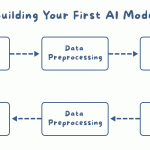Demystifying Machine Learning: A Beginner’s Guide to Understanding Key Concepts
In our data-driven world, machine learning (ML) has become a transformative force, revolutionizing industries and influencing our daily lives, from recommendation engines on e-commerce platforms to self-driving cars navigating our streets. Despite its seeming complexity, machine learning empowers computers to learn from data without explicit programming.
Defining Machine Learning
Machine learning, a subfield of artificial intelligence (AI), focuses on enabling computers to learn from data and make predictions or decisions. Unlike traditional programming, where explicit instructions are crucial, machine learning algorithms extract patterns from data to enhance their performance over time.
Main Types of Machine Learning
- Supervised Learning: This type involves training the algorithm on a labeled dataset, allowing it to make predictions for new, unseen data. Tasks include classification (e.g., spam or not spam) and regression (e.g., predicting house prices).
- Unsupervised Learning: Here, the algorithm works with unlabeled data to discover patterns without predefined labels. This is used for customer segmentation, anomaly detection, and dimensionality reduction.
- Reinforcement Learning: In this approach, the algorithm learns through interaction with an environment, aiming to maximize cumulative rewards over time. It’s widely used in training autonomous agents, including robots and game-playing AI.
How Machine Learning Works
At the core of machine learning are algorithms—sets of instructions that computers follow to perform tasks. Through a process called training, these algorithms learn from data. During training, the algorithm is exposed to a dataset, iteratively adjusting its parameters to minimize errors, gradually improving its ability to make accurate predictions or decisions.
How Machine Learning Will Improve
As a rapidly evolving field, machine learning sees continuous development of new algorithms and techniques. With increasing sophistication and available data, transformative applications are expected in the future.
How You Can Use Machine Learning
No longer confined to data scientists, machine learning is accessible to all. Cloud-based platforms and user-friendly tools, alongside numerous online courses and tutorials, make experimenting with machine learning achievable.
Benefits and Challenges of Machine Learning
Benefits:
- Improved Decision-Making: ML analyzes large datasets, identifying patterns difficult for humans to detect, leading to better decisions in medicine, finance, and marketing.
- Automation of Tasks: ML automates repetitive tasks, allowing human workers to focus on creative and strategic endeavors.
- Personalization: ML personalizes experiences, recommending products or services tailored to individual users.
Challenges:
- Data Bias: Biased training data can perpetuate bias in ML algorithm predictions.
- Explainability: Understanding how complex ML models make decisions can be challenging.
- Ethical Considerations: ML usage raises ethical concerns, including potential discrimination and privacy violations.
Conclusion
Machine learning is a powerful tool poised to transform our lives. Exploring its capabilities must be done responsibly and ethically. For innovative machine learning solutions tailored to your needs, consider partnering with Inventam Tech Solutions Pvt Ltd. Unlock the potential of machine learning for the benefit of society.













